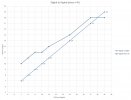Jean.Francois
Member
- Joined
- May 31, 2022
- Messages
- 83
- Likes
- 312
Hi,
Previously in the dynamics of music, we saw the difference between the dynamics of the medium and the dynamics of the music, as well as the effects of dynamic compression on the music in terms of distortion.
Today, we will discuss another aspect, the impact of dynamics on tape or vinyl recording.
The subject seems simple, we transfer the digital file to tape or vinyl and it is reproduced with little or no modifications.
To do this, we will use a test master file that includes the same musical sample with a different DR ranging from DR19 to DR7 as shown in the graph below :

This master file is burned on vinyl and played on a turntable. We then obtain the following result:

We notice that the variation is only from DR17 to DR10. In particular for the low DR, we notice that we do not go below the DR10.
To better represent this phenomenon, here is a synthesis curve which presents on the horizontal axis the DR value of the master from DR7 to DR19, and on the vertical axis the DR result after the playback of the vinyl cut with this master:

We can see that the vinyl does not go below DR10 in this example. This increase is therefore a distortion generated during the cutting and playback process compared to the original master.
Why this result? Vinyl is analog and it uses electromagnetic and mechanical means that give it a specific functioning. This operation is not compatible with certain digital treatments like the use of the Brickwall limiter which strongly distorts the signal in the digital world.
To go further in this test, the same operation is carried out with a magnetic tape on which we record the reference master. On playback, we obtain the same phenomenon as shown by the synthesis curve grouping the vinyl and the tape:

What can we conclude :
Jean-François
Previously in the dynamics of music, we saw the difference between the dynamics of the medium and the dynamics of the music, as well as the effects of dynamic compression on the music in terms of distortion.
Today, we will discuss another aspect, the impact of dynamics on tape or vinyl recording.
The subject seems simple, we transfer the digital file to tape or vinyl and it is reproduced with little or no modifications.
To do this, we will use a test master file that includes the same musical sample with a different DR ranging from DR19 to DR7 as shown in the graph below :

This master file is burned on vinyl and played on a turntable. We then obtain the following result:

We notice that the variation is only from DR17 to DR10. In particular for the low DR, we notice that we do not go below the DR10.
To better represent this phenomenon, here is a synthesis curve which presents on the horizontal axis the DR value of the master from DR7 to DR19, and on the vertical axis the DR result after the playback of the vinyl cut with this master:

We can see that the vinyl does not go below DR10 in this example. This increase is therefore a distortion generated during the cutting and playback process compared to the original master.
Why this result? Vinyl is analog and it uses electromagnetic and mechanical means that give it a specific functioning. This operation is not compatible with certain digital treatments like the use of the Brickwall limiter which strongly distorts the signal in the digital world.
To go further in this test, the same operation is carried out with a magnetic tape on which we record the reference master. On playback, we obtain the same phenomenon as shown by the synthesis curve grouping the vinyl and the tape:

What can we conclude :
- Analog media have their own characteristics that must be respected to obtain a faithful reproduction on these media. Therefore, a specific master is needed for these media.
- The use of brickwall limiters generates distortion, and if you burn a vinyl or record a tape from this type of digital master, you generate distortion again. It's a double punishment by accumulating distortion twice. So it's anything but high fidelity.
- Measuring the DR on analog media is possible, but it does not always allow you to deduce the DR of the master that was originally used.
Jean-François

